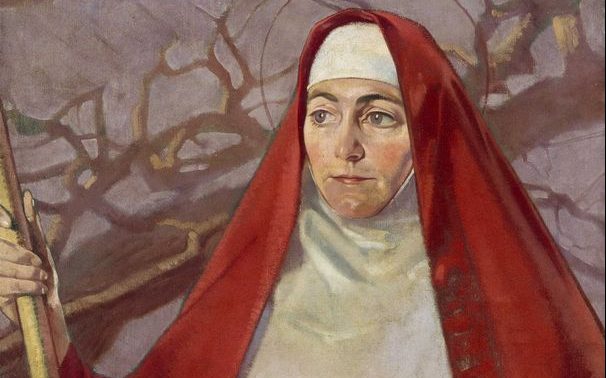Early in our marriage my husband, Stephen, an Irish immigrant to the United States, was having trouble sleeping. He was happy enough with his new life in Chicago, but a combination of culture shock concerning all things American and simply missing the familiar ways of his homeland left him vaguely restless and disoriented, a state that appeared to manifest itself most powerfully at night, once the lights went out and the noise of the day died away.
So Stephen appealed to an old family friend, St. Brigid, to assist him in acquiring a peaceful night’s sleep in his new homeland of choice.
St. Brigid is a favorite saint of my husband’s for a reason many of us can appreciate: His grandmother had a particular devotion to her that Stephen remembered from his childhood.
So on the eve of St. Brigid’s Day, February 1, Stephen hung his pillowcase out the window of our Chicago condo. He assured me that Irish folk everywhere would be doing the same with an assortment of bedclothes, linens, and hankies so that St. Brigid could “pass over” during the one night of the year she returns to the earth to bestow special blessings on anyone seeking her assistance.
Given the fact that our neighbors across the courtyard saw the pillowcase and, thinking we were in some kind of distress, almost called 911, I was quick to realize that I am not the only North American unfamiliar with this Celtic saint and unappreciative of the customs and legends surrounding her life. I needed to “re-remember” St. Brigid and that the ways of my Irish ancestors aren’t just quaint little superstitions.
Many Irish-Americans have lost a sense of the guiding gospel principles and cultural norms that have defined and continue to define an extensive amount of Irish belief and behavior. Nothing a little help from the likes of St. Brigid can’t fix.
Second only to St. Patrick in the esteem in which the Irish hold her, St. Brigid was born just north of modern-day Dublin, the child of an Irish chieftain and his wife, who was an early convert to Christianity.
Legend has it that her mother took Brigid to hear St. Patrick preach, and she became captivated by the message of the gospel. She refused to get married, which in her time and place usually meant an arranged marriage for strengthening political and familial alliances, and was determined to devote her life to God.
Over time she drew many Celtic noblewomen into the circle of her influence and became an abbess, establishing many convents throughout the island. She was legendary in her compassion for the sick and for her God-given abilities to heal them.
Perhaps the most famous story describes how she sat by the bedside of a dying Celtic chieftain, consoling him with her testimony about the power of the Christian faith to overcome death.
As she spoke, she plaited an impromptu cross out of local river rushes, a practice many Irish schoolchildren still learn, resulting in the simple, four-armed cross that graces many Irish doorways to this day.
St. Brigid’s feast day is on what has been traditionally recognized by the Irish as the first day of spring, and in the pre-Christian era it was the feast of Imbolg, a goddess who heralded the arrival of spring.
Although February 1 seems a bit early to be celebrating spring to many of us in North America, in Ireland one truly does begin to feel the power of winter wane at this point and may even see spring flowers pushing up through the mud and the muck, heralding brighter days to come.
St. Brigid’s Feast Day can be celebrated by hanging a white piece of cloth, a sheet, or even just a ribbon outside one’s window or door for her to bless as she passes by during the night. The blessed and comforting piece of cloth is later used for prayer and especially for healing. Hanging linen out for St. Brigid to bless may have roots in the ancient practice of airing of linens during cold weather, which helped kill germs and freshen up the stale air in the house.
It is also a thoroughly Irish response to life. Traditionally the Irish have had a sense of the holy in all of life, seeing such simple things as water and fire as blessed and blessing their lives. The Irish have had prayers and blessings for most of the quotidian elements and practices of any given day, from rising in the morning to banking hot embers in the hearth at bedtime.
Irish theologian and author John O’Donohue has written most poignantly in Benedictus: A Book of Blessings from a perspective that is thoroughly informed by his “Irishness”: seeing blessings as well as the “need to bless,” which is simply the earnest response of a grateful heart, as the very fiber of our relationship with the divine.
Another tradition on St. Brigid’s day is leaving the saint an oatcake—common food of her day—slathered with some butter as a snack, and perhaps a nibble for one of her cows, which, legend has it, often accompanied St. Brigid on her travels throughout Ireland.
St. Brigid was particularly fond of animals in general, and cattle and butter-making in particular, and thus became the patron saint of such mundane yet vital Irish concerns as sheep-rearing, cattle-herding, and dairy-farming.
St. Brigid was also said to have been a renowned brewer of ale. Lifting a pint in honor of this earthy, practical, and compassionate Irish woman seems an entirely appropriate way to celebrate her feast day, as is reciting the prayer attributed to her, part of which invokes:
I should like a great lake of beer for the King of Kings, and I should like the angels of Heaven to be drinking it through time eternal.
In coming to know or reacquaint ourselves with St. Brigid, we may very well find that the Irish penchant for blessing and gratitude becomes second nature, as we begin to find blessings in the ritual actions of the day and in each and every bit of matter and moment that make up our waking lives.
I can think of no better way to celebrate and honor the memory of this remarkable woman and saint. My own wish of blessing for all is to experience not only a reawakening to the divine promise of new life, but also a hearty and growing awareness of the sacredness of every aspect of our living and our being.
This article appeared in the February 2011 issue of U.S. Catholic (Vol. 76, No. 2, pages 47-48).
Image: Wikimedia Commons














Add comment